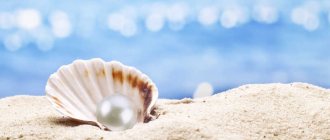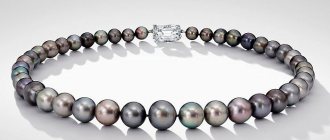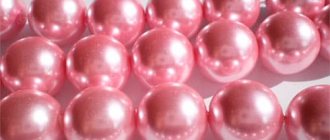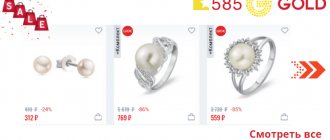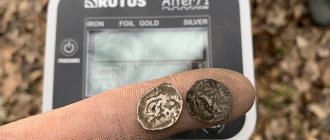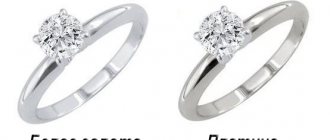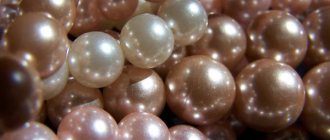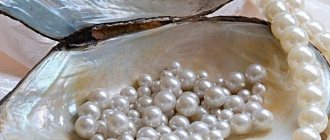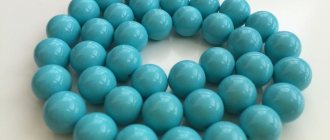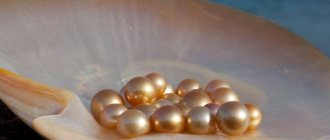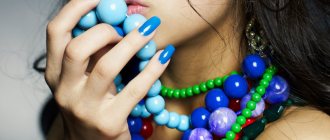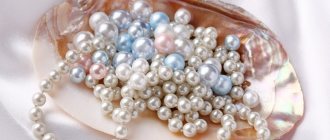Did your pearl earrings attract you with their mother-of-pearl shine? It seems that the shape of the beads is correct and they sparkle as they should. And the seller nods contentedly: “It suits you very well!” What if they sell an imitation under the guise of an original? Or is a river specimen passed off as a sea specimen? We reveal secrets that will protect you from ill-conceived investments: we figure out how freshwater pearls differ from sea pearls.
Why is it different?
A pearl is formed by a mollusk when a foreign substance enters the shell. The final result depends on the type of “house”, the composition of the water, and the ripening time of the pearls.
The pearlescent secretion produced by sea mollusks is not the same as that of river mollusks. The water of the seas and oceans is richer in chemical and biological diversity of elements. Therefore, sea and river (also called freshwater) pearls are not the same externally and internally.
Interesting Facts
Since freshwater pearls are usually smaller than sea pearls, they are very rarely used as a separate piece of jewelry. Since ancient times, its use as beads has been popular for creating entire panels and lining the outfits of the nobility, while the sea pearl, large and attractive in itself, serves as a central element along with precious stones.
There are cases when, due to the irregular shape of river pearls, they were valued more than sea pearls, since mystical properties and abilities were attributed to them.
Growing technology
The pearls that go on sale are cultured material, that is, grown on river and coastal farms. Natural ones have not been mined for half a century. This is officially prohibited because nature suffers.
The second reason is unprofitability. Of the thousands of shells raised from the bottom of the sea, only three or four contain what you need. On the farm, every shellfish is guaranteed to produce results.
Nautical
Grown on the shores of tropical seas. The process is more difficult and risky than on the river, since the farm may be hit by a storm, the water temperature will drop and other factors. This will affect the well-being and vitality of the mollusk. In addition, one pearl is always formed in the shell, regardless of the number of embryo inclusions.
River
The growing technology is different, but easier. The closest method to nature is nuclear-free. Sand grains are placed inside the mollusk for three to eight years. Human participation consists in controlling the composition, temperature of the water, and regularly “stirring” the shells so that the pearls are formed evenly. As a result, one mollusk produces up to ten peas.
The second method is combined. Mabe pearls are also grown in freshwater shellfish. However, the embryo is not a grain of sand, but a hollow plastic sphere on which layers of nacre are deposited. After extraction, the void is filled. The advantage of this method is the impeccable layering of the round pearl, without flaws on the surface.
River hatcheries are common in China - on former rice plantations.
Mining freshwater pearls
Freshwater pearl farms operate all over the world. China is the leader in this area, although centuries ago in deep Russian rivers people found wild pearls in sufficient quantities to embroider sundresses and hats with them.
You can try to find a pearl-bearing shell now. But we must understand that this matter will require effort and time. It is important to choose oysters from the very bottom of a fresh reservoir.
There are several parameters that will allow you to calculate the shell hiding the pearl:
- Deformed doors;
- Defects, chips and other signs of damage;
- Lumpy shell surface.
The shell must be opened to find out for sure whether there is a pearl in it.
The main differences between pearls of different origins
It is easy to distinguish river pearls from those created in the sea even by external signs, so attentiveness is enough to establish the origin.
Form
The first difference between freshwater pearls and any marine species. Nature or man are not capable of growing a perfectly round pearl. However, the marine material is as close as possible to this form. In pearls from rivers, the ball is rare. More often it is an elongated oval, a drop, an egg or another shape - arbitrary, irregular, bizarre.
The surface also differs. In freshwater it is almost always a relief with bumps and indentations. Smooth, as if ironed, is rare. The sea one is the opposite - it is smooth. Deviations like baroque pearls are rare and prized by designers.
Shine
An important property that is distinguishable visually. The freshwater specimen is matte and dull, which makes it different from the sea specimen. A pearl from the sea has a bright mother-of-pearl shine with iridescence that plays in the light.
The radiance and brightness of the surface is created by the alkaline composition of the water that enters the mollusk into the sea. A high concentration of salts polishes the surface of the pearl during ripening. Fresh water lacks this quality, so the result is more modest.
It is easy to distinguish freshwater pearls from sea pearls, having both types in front of your eyes. The sea pearlescent gloss and river matte are obvious.
Size
Freshwater pearls are traditionally smaller. River pearls were grown faster (less than two years), so they were no larger than 6 mm. Today, manufacturers have increased the period (3–6 years), as a result the material has become larger (9–16 mm), comparable to seafood products.
Color and tone
It is believed that all pearls are equally noble in appearance. In fact, sea and river pearls have differences.
The colors of freshwater material range from cream to lilac-purple and brownish. There are no black or bright pink river pearls. But bluish and greenish shades are its exclusive. Sea pearls do not have this, although the range of their tones is wider - from white to black.
Pearls from the sea are evenly colored and rich. River stone is not bright, the color is fragmentary.
As for classic white pearls, sea pearls are distinguished by their uniform whiteness, without the slightest color flaw. Grayish or yellowish spots are visible on the surface of the river.
Nacre
Visually, sea pearls appear more pearlescent. In fact, their coating is thin - 0.5–6 mm. Freshwater specimens consist almost entirely of mother-of-pearl.
The reason is the embryo on which the precious layers are deposited. It is smaller in river shells than in mollusks living in the sea.
Durability
The cold water of the river hardens the pearls. Therefore, freshwater pearls acquire increased wear resistance and strong layers of nacre. The warm water of the tropics, in which marine pearls mature, makes them aristocratic, but vulnerable to the external unfavorable environment. Everything is like people.
Therefore, if you plan to wear the beads or bracelet often, it is better to choose freshwater material. Delightful pearls from the sea do not withstand intensive use. This is an option for special moments or events.
You can distinguish sea pearls from river pearls by the degree of wear of the material. For example, in inherited beads. If they shine as if they were bought yesterday, it is guaranteed to be a freshwater stone. Antique jewelry made from sea pearls fades and becomes partially matte. The layer of mother-of-pearl wears off, especially in the places where the beads touch.
Price
Pearls from the sea are more expensive than pearls from the river. The difference is due to several factors:
- production technology - sea beauty takes longer to grow, plus the hassle associated with keeping oysters;
- productivity - one oyster living on the sea coast produces one pearl, a river shell can easily accommodate a dozen similar inclusions.
Freshwater pearl jewelry is affordable. For example, the cost of a quality pearl necklace is $45–55. The price of marine material is five times higher, that is, a product of comparable dimensions will cost $250–300.
How to distinguish a fake?
There are fake pearls that can be easily distinguished from real ones, while others are more difficult to recognize. Here are some tips to help you figure out if you are dealing with originals.
Dental test.
If you rub a real pearl against your teeth, its surface should be rough. If the surface is too smooth, it is usually a fake. However, this method is far from scientific and is not the most accurate.
Real pearls are rough.
If you look at a natural pearl through a magnifying glass, you will clearly see that its surface is uneven and slightly rough.
You will also be able to see how uniform or smoother the surface of the fake is.
Real pearls have imperfect color.
Examine the pearl closely in a well-lit environment.
If it is genuine, the color will be uneven and you will be able to see the transition to different tones. The fake will not show the same effect - its color will not vary.
The holes in real pearls should be small and even.
Real pearls tend to have smaller holes than fake ones. Since great attention is paid to maintaining the integrity of the pearls, the holes are drilled as small as possible.
Another clue is that the top layer of fakes tends to peel off easily and the holes will appear uneven. A similar effect is not observed in real pearls.
The shape of real pearls is uneven.
Natural pearls are not perfectly shaped because the natural process that creates them is not as precise as a machine.
Genuine pearls will also have irregularities on their surface.
Fake pearls, on the other hand, have a spherical shape that looks too perfect, as if the pearls were made.
Warmth test.
Real pearls usually take longer to heat up when held in your hand than fake ones. If the pearl is relatively warm to the touch, this may be a clue that it is not real.
However, this test is far from perfect and is highly dependent on the material from which the fake is made. Plus, you'll need a real gem for comparison.
A real pearl often weighs more than a fake one. Genuine pearls are typically heavier than fake pearls, which are often made from plastic or other lightweight material.
However, this rule is not necessarily true in all cases, so use the weight simply as another clue and not a definitive proof.
Where is the best place to check?
It is not difficult to recognize the nature of pearls. But how can you check it for sure? It is more convenient to do this in a jewelry salon, where everything is clearly visible and there is no need to rush. You can calmly examine the stone, touch it, and evaluate the texture of the mother-of-pearl.
Tags on jewelry and accompanying documents will help. It's easier to appreciate the differences when you have both views in front of your eyes at once. The assortment of the salon allows this.
Today, pearls of different origins and prices are available. The sea mineral is expensive, but aristocratic.
It is possible to find river specimens grown using the latest technologies. Their aesthetic appeal is not inferior to those obtained from the sea, they are more durable to wear, but more pleasant in price. Therefore, you should proceed from your own financial capabilities, preferences, and purpose of purchase.
Properties and Application
The main area of application is in jewelry making. The stone symbolizes nobility and prosperity. It differs from other stones in its grace and delicate shade.
River rock is used in cosmetology. The pearls are crushed and then added to the powder. They make products from it to care for the face and neck. Thanks to this, cosmetics acquire a tonic and rejuvenating effect.
In addition, the mineral has magical, healing properties. Psychics often use freshwater pearls in rituals. In Rus', religious attributes used to be inlaid - icons, books, clergy clothes.
Physical properties
The main physical characteristics of freshwater pearls:
- the chemical composition is due to aragonite and conchiolin;
- color: white, cream, yellowish, soft pink, ivory, lavender;
- pearlescent shine;
- opaque;
- hardness: 3–4 on the Mohs scale;
- fracture: shelled;
- density: 2.60–2.78 g/cu. cm;
- refractive index: 1.52–1.66.
View this post on Instagram
Posted by Elena (@aurora_beads_antique) Nov 12, 2022 at 8:02 PST
Medicinal properties
Lithotherapists note the features of pearls aimed at the prevention and treatment of certain diseases:
- Helps with problems with the central nervous system, has a beneficial effect on a person’s mental state, improves memory and increases concentration.
- Promotes good functioning of internal organs: liver, kidneys, stomach.
- Cleanses the body, helps with infectious eye diseases.
- Used for problems with the skin of the face and hands, strengthens hair.
- Powdered pearls have anti-inflammatory and hemostatic properties. This remedy will help in the treatment of burns and some gastrointestinal diseases.
Magic properties
Since ancient times, magicians and sorcerers have revered pearls as a stone with powerful positive energy. He is able to influence a person’s life, changing it for the better:
- Along with pearls, money and abundance come to the house. It bestows longevity and good health on its owners.
- The stone represents love. If things are not going well for you on the personal front, you should buy an amulet. It will improve the relationship between lovers and prevent betrayal and omissions.
- Talismans will drive away bad thoughts and ward off troubles.
- Freshwater pearls help to establish contacts, sort out complicated situations, and solve problems.
Who is the stone suitable for according to their zodiac sign and name?
Pearl is considered a stone with feminine energy. It makes the character flexible, adds calmness and meekness to any temperament.
Astrologers especially recommend the use of amulets for Gemini and other signs of the water element. For them, the stone will become a talisman, bringing stability and harmony to life - exactly what these people love and value.
Other signs can also safely wear jewelry made from freshwater pearls.
But representatives of the fire element - Aries, Sagittarius and Leo - are better off refraining from everyday wear. Their hot temper can counterbalance the energy of the stone, which will turn its charms into harm.
The stone will best suit girls with names:
- Valentina;
- Catherine;
- Inga;
- Inna;
- Irina;
- Claudia;
- Marina;
- Margarita;
- Snezhanna;
- Elvira.
The difference between freshwater and sea pearls: shape, color, size, luster and nacre.
What are the differences between sea and river pearls, and how can you tell them apart? And in this case, jewelry masters talk about the following criteria by which they are distinguished from each other:
1. Shine. If it is a sea pearl, then it has a bright, characteristic mother-of-pearl luster that shimmers in the light, but a river pearl has a duller, matte shine. This is due to the properties of sea water - it is more alkaline, giving the stone a brighter shine.
2. Form. There are no ideally round, oval shapes, and river pearls are more uneven and have an oblong appearance, while sea pearls are more rounded. It is the spherical shape that indicates sea pearls, which are more accurate and ideal.
3. Durability. River stones are stronger and more durable, although they are not as bright and shiny as sea stones. The main thing in this case, in my opinion, is proper wearing and care, as well as storage.
size 4. As experts, including myself, say, river gifts are smaller in size than sea gifts. And they grow much faster than sea ones.
5. They are also differentiated by tone and color. Many people are accustomed to thinking that all pearls have a noble, identical shade, but no. If we talk about the range of colors and shades of river pearls, it can vary from light, cream to lilac-lilac. But there will be no black or pink among them, but greenish or bluish shades will be fine. In marine species, the color range varies from white to rich dark, black shades.
Sea pearls
Sea pearls
Plus, sea stones have a more uniform color, while river stones can be colored fragmentarily. I hope all this information will help you understand for yourself what pearls are now in front of you in the noble thread of jewelry.
Pearl jewelry
Freshwater pearls are often used by craftsmen to make jewelry. Beads, earrings, and pendants are in greater demand. The best setting for the mineral is considered to be gold and silver, but other metals are not excluded. For beads, strong threads are most often used, and a stone is placed on them.
Jewelry made from mother-of-pearl minerals will forever remain in fashion. Coco Chanel was practically in love with them, thanks to her pearl beads became classics.
Sets of pearl products look very beautiful. For example, a necklace and earrings are perfect for a formal look. A ring with a pendant will complement everyday clothes, making the look more flirtatious and attractive.
See how a product made from this type of pearl looks in the video:
View this post on Instagram
Publication from HANDMADE JEWELRY (@pasdemarque_ru) June 6, 2019 at 12:54 PDT
View this post on Instagram
Publication from Lena Bukreeva (@lena_podarkivsem) May 31, 2022 at 9:09 PDT
View this post on Instagram
Posted by Katerina (@bsmons) May 31, 2022 at 4:09 PDT
How to clean freshwater pearls at home
You need to follow some rules when caring for pearls so that they delight you with their mother-of-pearl shine for a long time:
- If you are dealing with a necklace, you should not let the thread get wet. It will be enough to wipe the beads with a cloth soaked in foam. The thread should be changed every few years.
- Other jewelry can be washed with soapy water and a soft brush. Or use dry cleaning options: polishing with a starched cloth, crushed cork, a cloth soaked in dissolved vinyl acetate and olive oil.
If you don't want to resort to extensive cleaning methods for your jewelry, you can simply wipe it with a microfiber cloth after wearing it.
River pearls, although slightly inferior in beauty to sea pearls, are distinguished by their durability and fidelity to their owner. It will perfectly complement the wardrobe of any woman, regardless of age. Will attract good luck and give health.
Which pearls would you prefer: saltwater or freshwater? Write your ideas in the comments and don’t forget to repost on social networks. Best wishes.
How to clean pearls at home and how to store them
Natural freshwater pearls are stronger than sea pearls, but they are not stone; they are vulnerable and subject to destruction over time. To extend the life of mother-of-pearl beads, you need to follow simple operating rules and provide delicate and regular care.
For example, to maintain the shine of a pearl, you need to clean it from time to time. Under no circumstances should this be done with cleaning agents or vinegar. The latter will corrode the layers of mother-of-pearl and will be certain death for the jewelry (some people use it to check whether pearls are real or not).
Clean products with warm soapy water and a soft cloth. Before storing in a box (kept separately), the pearls are allowed to dry and rubbed thoroughly.
What kind of stone is Mallorca?
The Spanish jewelry company Majorica has discovered and patented an exclusive method for producing imitation real pearls. The composition and formula of the material, produced at an industrial enterprise without the participation of marine life, is kept secret. The company only demonstrates to everyone what Majorca pearls are and how they are made. The process of making the base can be observed in the company store on the island of Mallorca, where the jewelry production and the company's head office are located.
The artificial material is balls of glassy mass. The master makes each pearl by hand by heating a stick of translucent substance. The molten soft mass is wound around a metal rod.
The cooled balls are mounted on a wooden frame and sent to the workshop for finishing. There they are coated with a paste that includes powder made from real pearls and mother-of-pearl. The company also keeps the full composition of this paste secret. Dried pearls, already similar to real ones, are polished with special soft brushes. At the same time, imitation major pearls acquire the luster characteristic of natural stone of the highest quality.
Thanks to modern technologies, Mallorca is painted in a variety of colors: yellow, black, pink. They imitate expensive and rare varieties of natural cultivated stone (blue, for example), and paint the balls in colors unusual for the mineral, applying gold or silver.
Compatibility with other stones
Pearls are incompatible with sapphire, which reflects the surface of water. He does not like proximity to the stones of the Earth, especially jasper, cacholong, morion and chalcedony.
The optimal proximity is with other water (except sapphire) stones:
- emerald;
- opal;
- moonstone;
- aquamarine;
- alexandrite.
Jewelry with pearls.
Partnership with Air is acceptable:
- amethyst;
- uvarovitis;
- topaz;
- hyacinth;
- chrysoprase;
- smoky quartz.
Avoid proximity to Fire minerals, especially ruby, diamond and all types of garnets, including greenish grossular.
